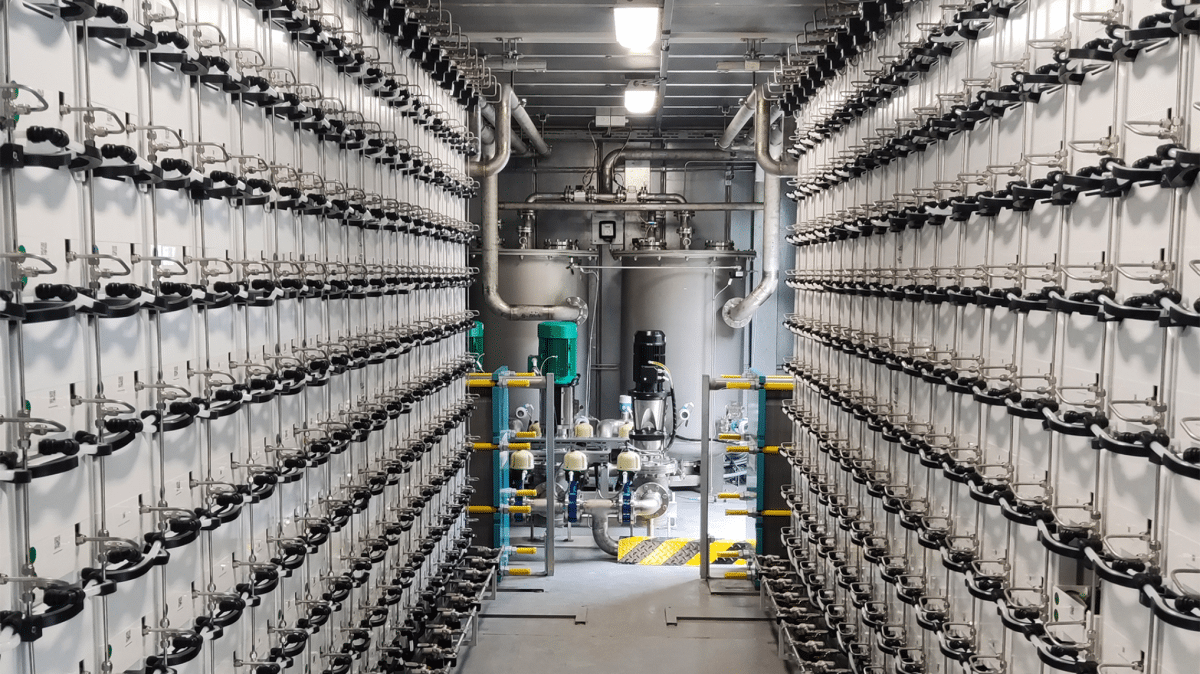Dark doldrums: Electrolysers are the bottleneck
In order to survive longer phases without wind and sun, the German power grid alone will need around 40 terawatt hours of storage in the future. The most important bottleneck on the way there is the production capacity of the necessary electrolyzers, as the MIT Technology Review magazine reports in its current issue 2/2024 (now available at newsstands or here).
Advertisement
The network endured its toughest test so far this winter on Friday, December 1, 2023, late in the morning. Cloudy weather and weak winds met with high demand for electricity. Renewables could only shoulder just under 17 percent of the burden. Fossil fuel power plants stepped into the breach. Gas-fired power plants contributed around 16 gigawatts, and a further 28 gigawatts came from coal-fired power plants.
The coal phase-out planned for 2030 is still the smaller problem. In purely mathematical terms, the output of the installed gas power plants would initially be sufficient to fill the gap. At the latest, if Germany wants to get by completely without fossil fuels by 2045, things will be tight. There are a number of options for capping extreme load peaks – for example by expanding the European power grid, by shifting loads for large consumers or by using biomass more specifically.
More electricity storage is needed
But even if you exhaust all of these options, they wouldn’t be enough. So electricity storage is needed. To estimate the necessary capacity, Oliver Ruhnau from the Hertie School in Berlin and the British management consultant Staffan Qvist analyzed 35 years of energy and weather data at an hourly resolution. The longest periods of darkness lasted around two weeks at a time. But that wasn’t all: there were often several dark lulls in close succession. Then there is not enough renewable energy available to recharge the storage devices. Overall, phases with energy deficits (including storage losses) can last up to twelve weeks. Another finding: In the most extreme years, storage requirements were more than twice as high as in an average year. In order to be prepared for such extreme cases, Ruhnau and Qvist estimate the storage requirement at 36 TWh of electricity. Other studies come to similar magnitudes.
German pumped storage plants can currently supply almost 40 GWh. And new pumped storage lakes can hardly be built anymore, because they would have to flood entire valleys. A good 11 GWh of batteries are currently installed, most of it as home storage. The analysts at Frontier Economics believe that almost 300 GWh of large battery storage systems are possible in Germany alone by the middle of the century, but even this would only be a fraction of the demand. “With the technologies known today, only chemical energy storage devices (e.g. hydrogen or methane) are possible for the long-term storage of such large amounts of energy,” concludes the industry association VDE.
The crises of our time are coming together: war, global warming, environmental problems and technological developments. It seems like a labyrinth where the way out just doesn’t seem to come into view. The current edition at least tries to bring some order. Highlights from the magazine:
Contribution from hydrogen
Around 100 megawatts of electrolysis capacity are installed in this country to produce hydrogen. As part of the National Hydrogen Strategy, the federal government wants to expand output to 10 GW by 2030. That should be enough for around 28 TWh of hydrogen per year. If you add the conversion losses during electricity generation, this corresponds to just a quarter to a third of the assumed hydrogen requirement.
Even the 10 GW target is already ambitious. “Electrolyzers themselves could turn out to be a global bottleneck,” says a study by the Science and Politics Foundation. More than a third of global production capacity is already located in China, and the trend is rising. There is therefore a risk of further geopolitical dependence. Creating the necessary factories within the EU would require “unprecedented progress” in production and installation, which “would probably only be possible with wartime-style central control of resources.” In any case, importing hydrogen would not solve the resource problem, as potential exporting countries are also competing for the same capacities among electrolyzer manufacturers.
Another problem: Because of the conversion losses, the electricity system has to generate a multiple of the energy that it can later take from the storage. Would the output of renewables even be sufficient for this? The federal government’s plans call for an expansion of 145 GW of wind energy and 215 GW of solar systems by 2030. For comparison: The maximum load in the power grid was previously in the region of 80 GW. So there should be regular surplus green electricity – if the expansion really progresses as planned. For offshore wind power, for example, there is a lack of the necessary installation ships and suitable ports. Neither can simply be brought about by law.
“All of these outlooks into the future assume that all decisions are always made rationally,” writes Michael Sterner, professor of energy storage at the OTH Regensburg, in his book “This is how we save the climate.” “And that the transformation takes place under ideal conditions – that is, there are always enough workers and materials available at all times. We know from our experience that this is not the case.” A time buffer would therefore be good, says Sterner. “But we don’t have that. Unfortunately. Not anymore.”
Read MIT Technology Review here:
(grh)
To home page
